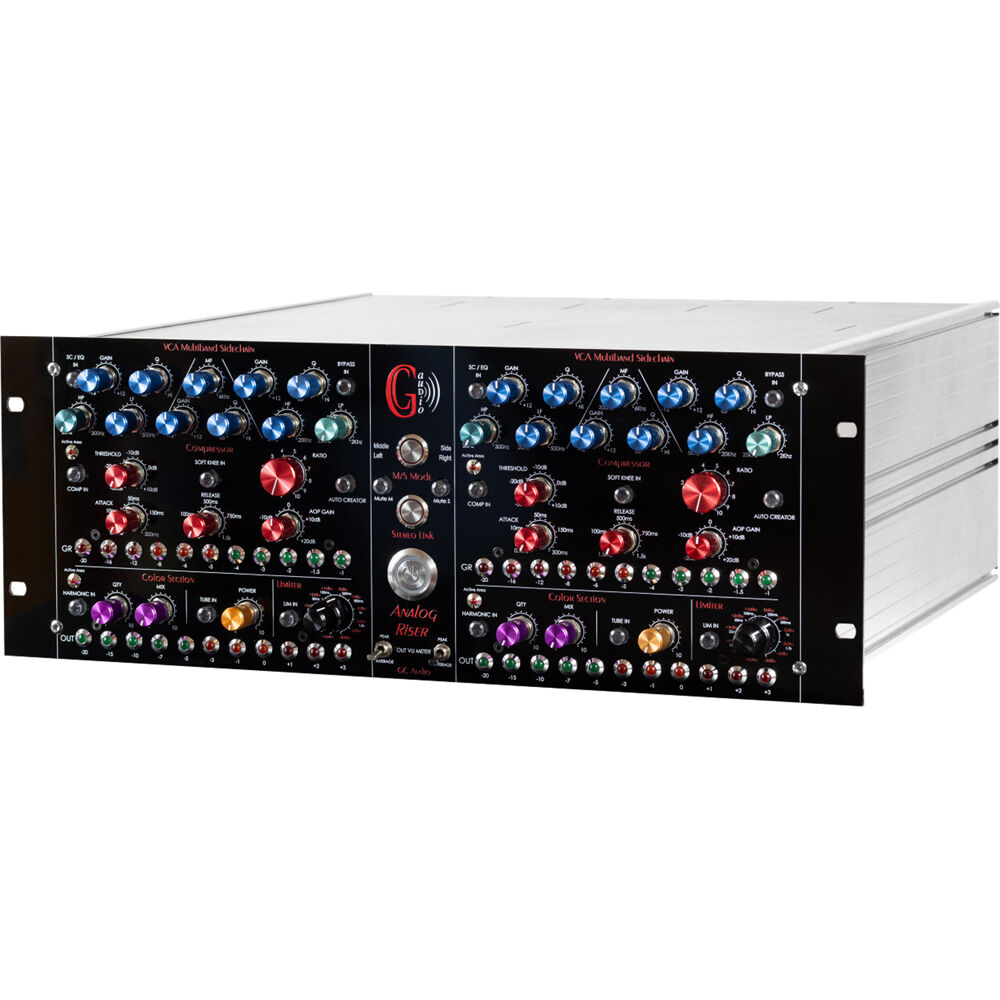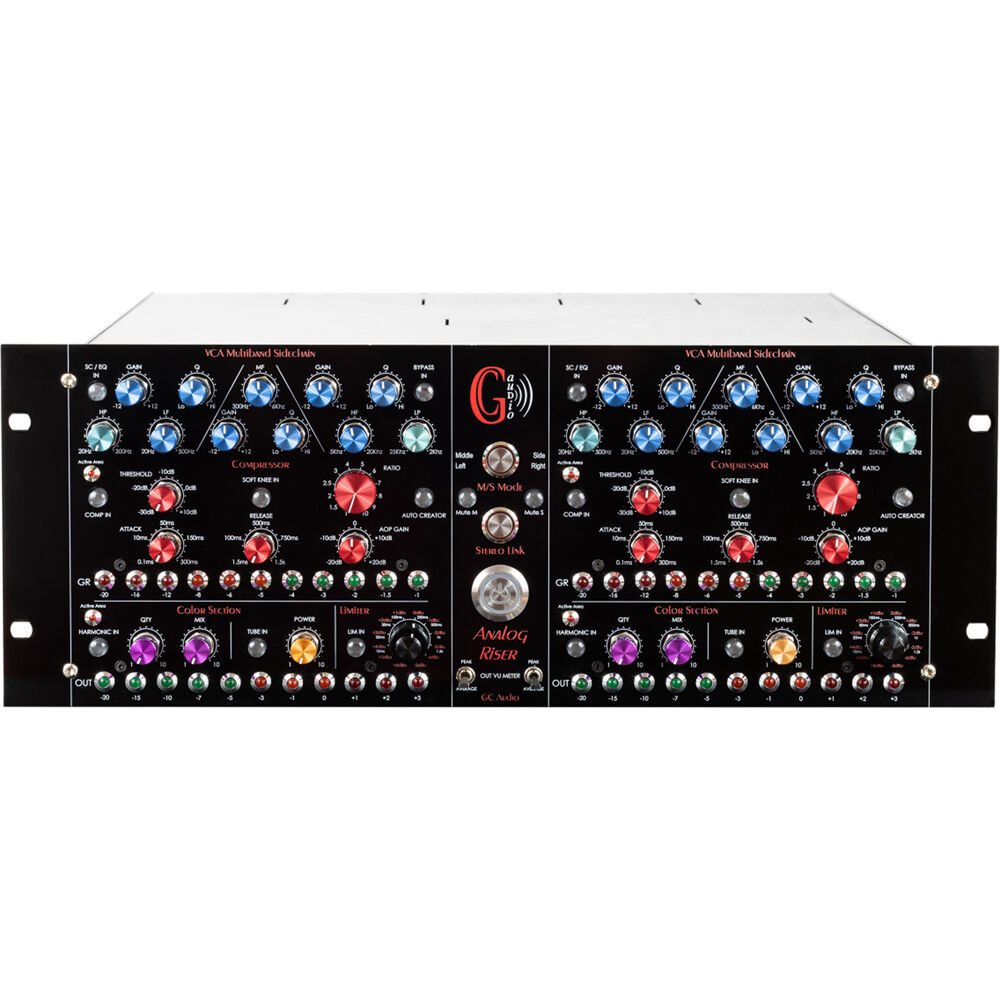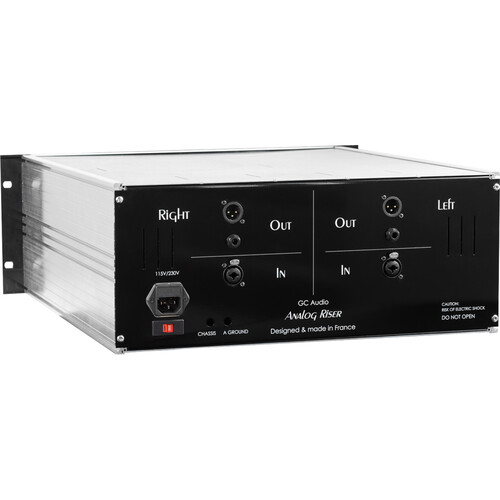GC Audio ANALOG RISER Overview
Combining five powerful forms of processing in one rackmountable chassis, the Analog Riser from GC Audio is a high-end multiprocessor for mixing and mastering applications, making it easy to obtain sharp, unique dynamics and harmonics processing. Built around five tubes, four VCAs, four Lundahl transformers, a hundred low-noise op-amps, Grayhill switches, IP knobs, and much more, the powerful combo of harmonics processing with M/S operation mode make the Analog Riser a unique beast.
Combining a 3-band EQ stage with variable Q and selectable high- and low-pass filters, a VCA compressor stage with 12 ratios and optional auto-attack and auto-release options, a harmonic generator stage with mix density control, a 12AY7 tube gain stage with up to 20 dB of gain, and a brickwall limiter stage with a fixed ultrafast attack time and stepped release controls, the Analog Riser has you covered in virtually any scenario. The unit can operate in full stereo, dual mono, and mid-side mode for unconventional processing. This unit can be manually switched between 115 and 230V operation for global compatibility.
Five Versatile Stages for Mixing and Mastering
3-Band Parametric EQ with Low- and High-Cut
Designed to define multiband contour for the compressor detection threshold, this stage can also be used as a standalone EQ. For example, to avoid compression pumping, a low-cut filter is often used in the side-chain to control instruments like the bass drum. However, this not only discriminates against the bass drum but the low-end of the track as a whole. With the multiband contour you can first find the exact frequency of the bass drum and only separate this frequency at the level of the compressor's release threshold.
In the opposite case, which may be desired for electronic music for example, you can turn up the gain only on the bass drum frequency which will give you a stable pumping with a good rhythmic behavior. More globally, the multiband VCA contour will allow you to compress, at different thresholds, the pleasant and unpleasant frequencies.
VCA Compressor Stage
This compressor is built around a state-of-the-art VCA and features full adjustment of the time, threshold, and gain make-up components. With impeccable characteristics in terms of signal-to-noise ratio and distortion, it is particularly stable.
Note that it is equipped with a new and original function: Auto Creator. In this mode, the attack and release are automatically adjusted. They will be globally fast but vary according to the speed of the input signal. The times will be different depending on the nature of the signal: transient or constant signal. This is a very interesting function on percussive sources or bass.
Harmonic Treatment Stage
This stage generates odd harmonics for adding color and saturation to your signals. It is possible to define the amount of harmonics generated as well as the density integrated into the input signal. The electronic design has been optimized so that this function adds a proximity character to the signal, thus treating it more like the high-end frequencies of the audio spectrum.
Tube Gain Stage
Each channel of this tube section consists of four 12AY7 tube stages, designed to extract the full essence of the signature tube character. A high-voltage EZ81 tube power supply is present and offers a high-quality choke filtering system allowing a very low residual ripple.
The Analog Riser allows two types of gain makeup: The discrete make up of the compressor stage, which will have a very transparent rendering, and the tube make up which allows one to color the signal, or even give it saturation. To use the maximum potential of the headroom of the tube stage, it is interesting to reduce the make up of the compressor stage beforehand.
Brickwall Limiter Stage
The last output stage of the Analog Riser is a brickwall limiter with 12 threshold positions. To avoid saturating your converters, the optimal setting is +4 dBu, which will give you 0 dBFS at the input of your DAW. By pushing the makeup gain to its limits, the dynamic range will be reduced and the overall volume impression will increase considerably without exceeding +4 dBu.
Three Modes of Operation
Dual-Mono Mode
The default mode when the Analog Riser is powered on, Dual-Mono mode is an analog processor with two completely independent channels, letting you process two distinct tracks simultaneously. In this sense, you can use the left side of the processor to mix/master the left in/out track and the right side of the processor for the in/out right track.
Stereo Mode
After hitting the Stereo Link button, the Analog Riser kicks into Stereo mode, which is dedicated to stereo bus compression. The limiter has no summing on the side-chain input in order to keep a faithful stereo image. Common threshold and VCA time control, calibrated from the factory, allows for a precise adjustment between the left and right channels.
An Active Zone Area LED allows you to define the zones for which knobs are functional. Although the potentiometers are linked, the functions of both channels work. Therefore, to activate a function, it is necessary to switch on the left channel and right channels.
Mid/Side Mode
Pressing the M/S button activates Mid/Side mode, which is dedicated to mastering and is a powerful tool for achieving different dynamic treatments between what is mixed in the center (mid) and what is mixed on the sides (side). The M/S encoder/decoder of the Analog Riser is built around dedicated differential amplifiers with laser-etched calibration, allowing for the most precise signal processing.
This mode remains completely analog, without analog-to-digital conversion or vice versa. An extremely unique function, the M/S processing can allow for unconventional settings, such as tube gain on the sides and discrete analog in the middle, as well as many more potential configurations with all of the Analog Riser functions.
GC Audio ANALOG RISER Specs
General
| Tubes | 8 x 12AY7 Tube (4 Stages per Channel) 1 x EZ81 Tube (Power Supply Bridge) |
| EQ Section | High-Pass Filter: 20 to 300 Hz, 12 dB/Octave Low-Pass Filter: 250 Hz to 20 kHz Low Frequency: 20 to 500 Hz, ±12 dB of Gain, Variable Q Mid Frequency: 300 Hz to 6 kHz, ±12 dB of Gain, Variable Q High Frequency: 5 to 20 kHz, ±12 dB of Gain, Variable Q |
| Compression | Threshold: -30 to +10 dB Ratio: 12 Steps, 1.5 to 10 Attack: 0.5 to 300ms (Plus Auto) Release: 1.5ms to 1.5s (Plus Auto) Make-Up Gain: -20 to +20 dB |
Inputs / Outputs
| Audio I/O | 2x Combo XLR-1/4" 3-Pin Line Input (1 Stereo Pair) 2x XLR 3-Pin Line Output (1 Stereo Pair) 2x 1/4" TRS Line Output (Side-Chain, 1 Stereo Pair) |
Power
| Power Source | AC Input |
| AC Input Power | Changing Voltage Requires Manual Switching 115 to 230 VAC, 50 / 60 Hz |
Physical
| Mounting | Front: 4x Standard Rackmount Screw |
| Color | Black |
| Material of Construction | Metal |
| Dimensions | Not Specified by Manufacturer |
| Weight | Not Specified by Manufacturer |
In the Box
- GC Audio Analog Riser Mixing and Mastering Processor Standard Version
- 2-Year Manufacturer Warranty
No posts found














